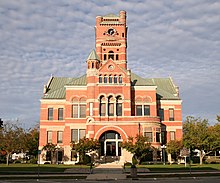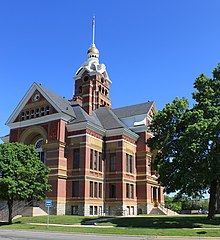| Revision as of 02:15, 17 October 2020 editCitation bot (talk | contribs)Bots5,446,196 edits Alter: url, template type. URLs might have been internationalized/anonymized. Add: isbn. Correct ISBN10 to ISBN13. | You can use this bot yourself. Report bugs here. | Suggested by AManWithNoPlan | All pages linked from cached copy of User:AManWithNoPlan/sandbox2 | via #UCB_webform_linked 1659/11719← Previous edit | Revision as of 22:31, 2 July 2021 edit undoAmpsgrands (talk | contribs)449 editsNo edit summaryTags: Mobile edit Mobile app edit Android app editNext edit → | ||
| Line 1: | Line 1: | ||
| ], Albion, Indiana]] | {{Short description|American architect}}], Albion, Indiana]] | ||
| ]]] | ]]] | ||
| '''Edward Oscar Fallis''', often known as '''E.O. Fallis''', was an American architect of ]. | '''Edward Oscar Fallis''', often known as '''E.O. Fallis''', was an American architect of ]. | ||
Revision as of 22:31, 2 July 2021
American architect

Edward Oscar Fallis, often known as E.O. Fallis, was an American architect of Toledo, Ohio.
A number of his works are listed on the U.S. National Register of Historic Places.
Works include (with attribution):
- First Church of Christ, Scientist, 2704 Monroe St. Toledo, OH (Fallis, E.O.;Yost & Packard), NRHP-listed
- One or more works in Fountain City Historic District, roughly bounded by Butler, Lynn, W. Wilson, Center, Portland and Beech Sts. Bryan, OH (Fallis, E.O.), NRHP-listed
- Benjamin F. Kerr House, 17605 Beaver St. Grand Rapids, OH (Fallis, Edward O.), NRHP-listed
- Lenawee County Courthouse, 309 N. Main St. Adrian, MI (Fallis, Edward O.), NRHP-listed
- Noble County Courthouse, Courthouse Sq. Albion, IN (E. O. Fallis & Co.), NRHP-listed
- Paulding County Courthouse, Courthouse Sq. Paulding, OH (Fallis, E.O. & Co.), NRHP-listed
- Valentine Theater Building, 405-419 Saint Clair and 402-412 Adams Toledo, OH (Fallis, Edward Oscar), NRHP-listed
- Williams County Courthouse, Main and High Sts. Bryan, OH (Fallis, E.O.), NRHP-listed
- Wood County Home and Infirmary, N of Bowling Green at 13660 County Home Rd. Bowling Green, OH (Fallis, E.O.), NRHP-listed
- Nasby Building, Madison Av and Huron St Toledo, Ohio.
See also
- Egyptian Theater, 452 Main St. Delta, CO M.S. Fallis Architect Co.), NRHP-listed
- Sacred Heart Church, 1025 N. Grand Ave. Pueblo, CO Willison & Fallis), NRHP-listed
References
- ^ "National Register Information System". National Register of Historic Places. National Park Service. July 9, 2010.
- Toledo: A History in Architecture, 1890-1914 By William D. Speck - Nasby Building. Arcadia Publishing. 2002. ISBN 9780738519784. Retrieved 28 April 2017.
This article about a United States architect or architectural firm is a stub. You can help Misplaced Pages by expanding it. |